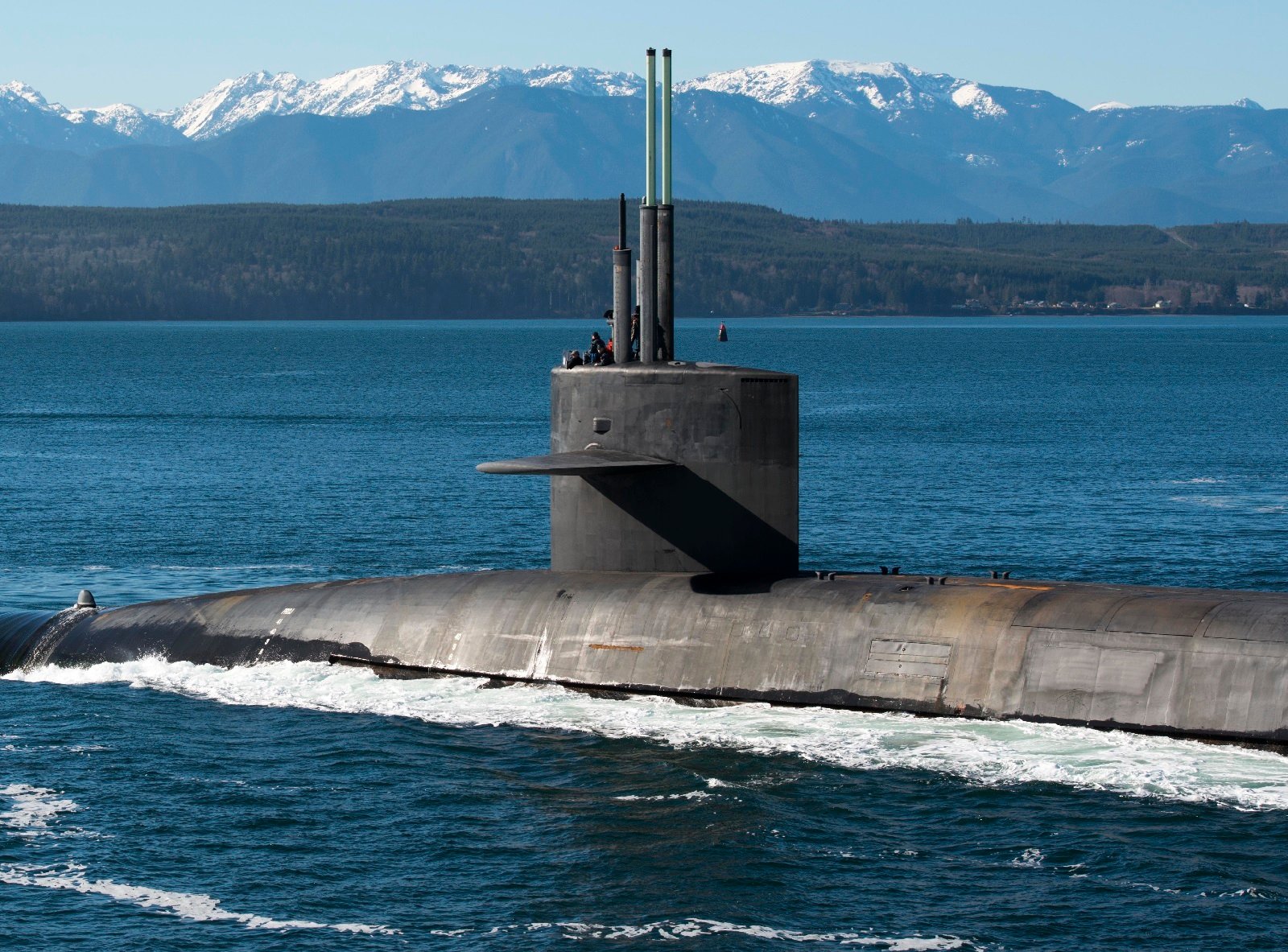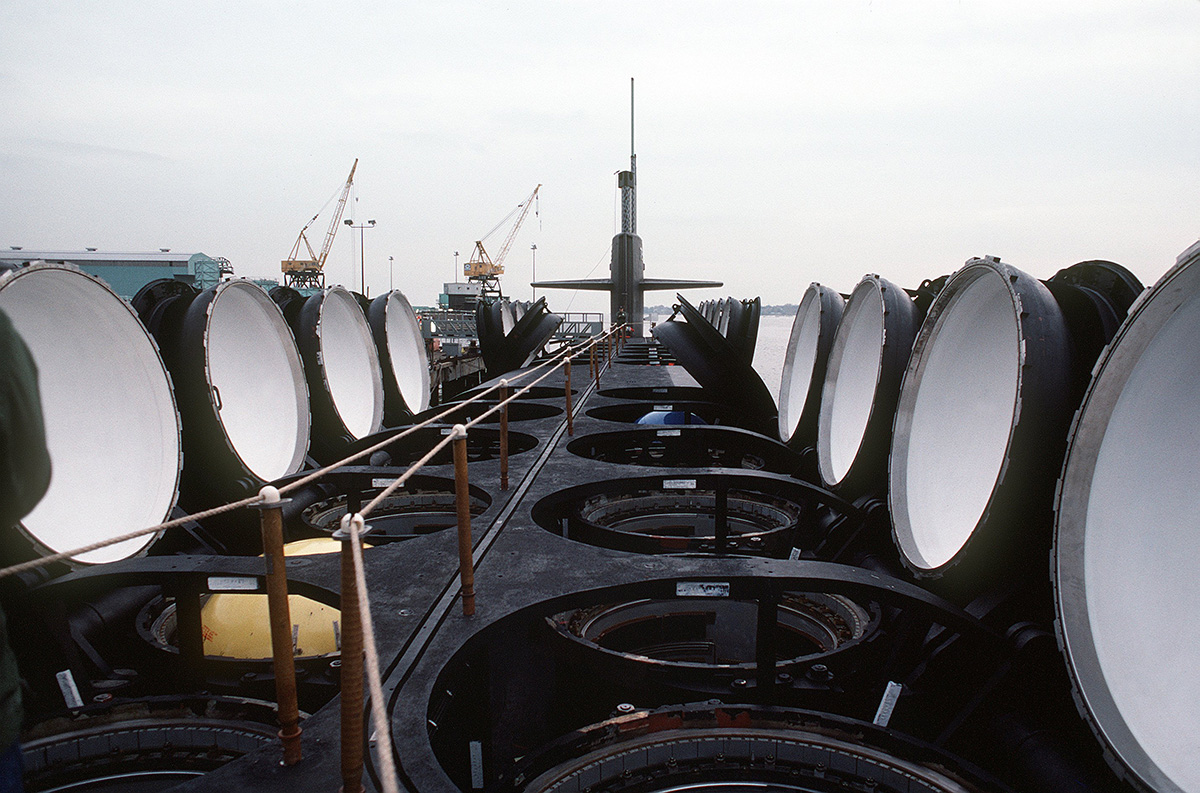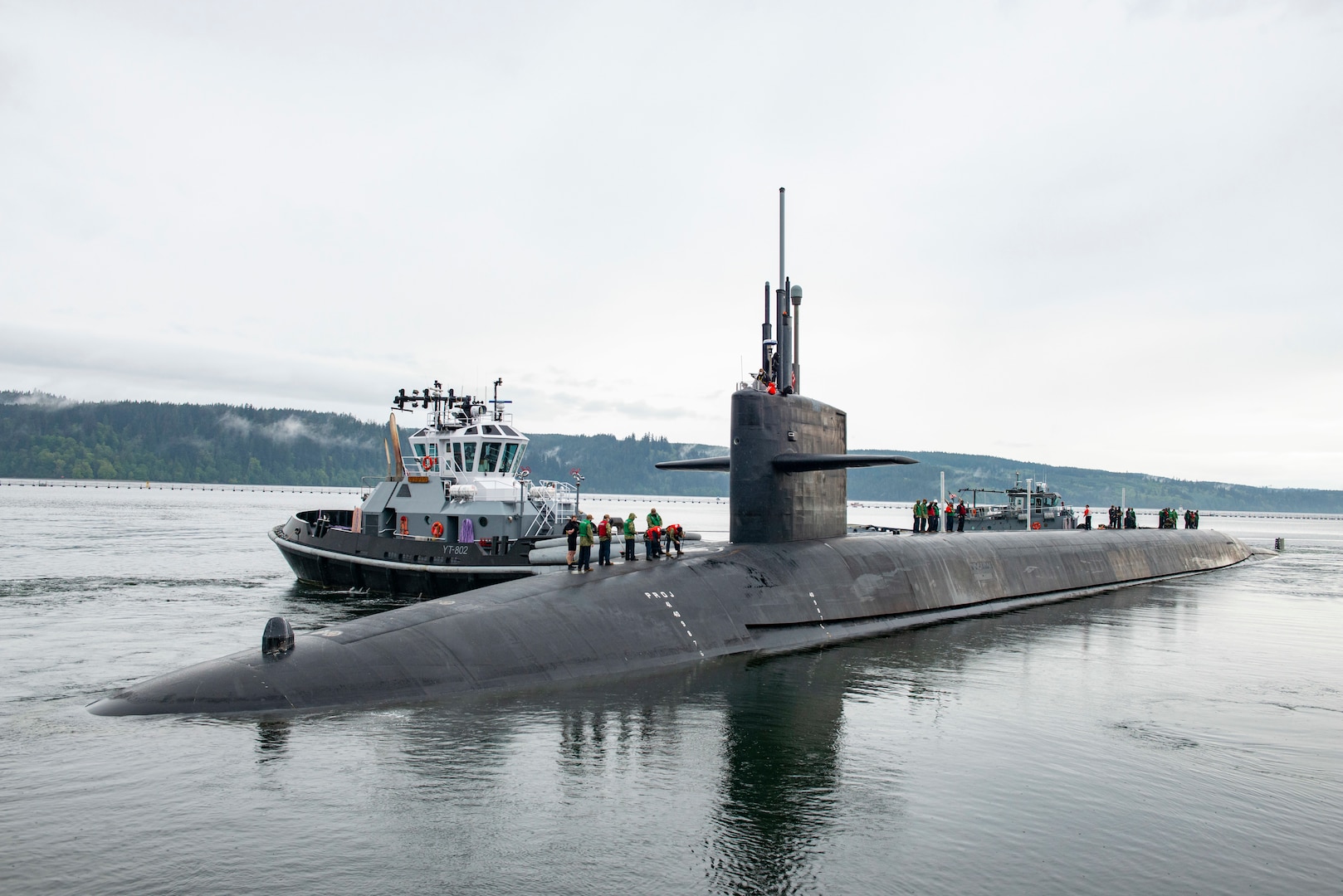Ohio Class Subs - The blue crew of the guided-missile submarine USS Henry M. Jackson (SSBN 730) transits Hood Canal as it returns home to Naval Base Kitsap-Bangor after a routine strategic defense patrol Sept. 30, 2015. U.S. Navy photo.
The Navy's need to provide "uninterrupted strategic deterrence" with its ballistic missile submarines requires it to meet two goals: development of new ships must be on schedule, and older ships must reach the end of their lives expected service.
Ohio Class Subs

That last one isn't easy — the Navy is counting on the Ohio-class guided-missile submarines (SSBNs) to last about 42 years each, something that's never been done before. America's longest submarine, the USS Boomer
Columbia Costs: Is It $100b Or $128b? Well, Yes. Read Kendall's Adm Memo.
(SSGN-726) is only 34 years old and still has eight more to go - a task that makes her a captain. Scott Pappano, his team at the Naval Sea Systems Command (NAVSEA) and other offices throughout the Navy.
Pappano, NAVSEA's program manager for strategic and attack submarines, told the USNI in a Jan. 28 interview that "we have a very well-engineered, well-engineered vessel that is designed for a 30-year service life." In 1995 the Navy commissioned submarine builder General Dynamics Electric Boat with an analysis of what it would take for the ship to last 42 years, and after several more trade studies NAVSEA decided in 1998 to continue the life extension.
Many of the ideas and challenges — both on the marine, mechanical and electrical (HM&E) side and on the non-propulsion electronic systems (NPES) side — that were discussed 20 years ago are now coming to a head, Pappano said.
It's clear, going into life extension efforts, that electronics need to be updated. Recently, however, the Navy has realized that the analog and tactical data processing systems that SSBNs use are not only more difficult to maintain and operate, but also will not be sustainable in the fiscal year 2018 due to the ability to get spare parts and more. the factors.
Pictures That Declare The Ohio Class Submarine A Ballistic Missile Beast
Pappano said the Navy decided to bring the SSBNs into the Federated Tactical Submarine Warfare Systems (SWFTS) program, an open architecture electronic system with regular hardware and software updates. Attack submarines and guided missile submarines - Four SSBNs, incl
It entered Norfolk Seaport last month for its mid-life engine overhaul and the 27-month period will be filled with work planned from the class's maintenance plan, as well as initiatives aimed at keeping the vessel ready and important to the second. Half of his 42 years.
The SWFTS equipment upgrade will be "easier to transport, easier to maintain" for the Navy and operators, and "it also brings good capabilities to the ship as well, making it a package of tactical attack submarine system," Pappano said. Much of the control room, computer station, sonar and more will be removed from the submarine while in dock for refueling and new computer servers and other equipment will be installed. It also gives the Navy the opportunity to install the Combined Ship Network and Enterprise Services (CANES) — one of the major modernization efforts the Navy is trying to plan for all ship classes in the Navy, which will make The most important and easiest SSBNs. To maintain and improve throughout their service life.

, as the fourth smallest SSBN, will be upgraded with SWFTS and CANES during its mid-life replenishment. Older ships can receive these upgrades during the second engineering update period (ERP), which reaches 32 years of service, or the work can be scheduled at another time when public shipyards can afford the work and the Commandant of the Navy does not wants it. Under.
Columbia Class Submarines
The Ohio-class guided-missile submarine USS West Virginia (SSBN 736) departs from the Norfolk Naval Shipyard in Portsmouth, Va. After an engineering fuel overhaul on October 24, 2013. US Navy photo.
(SSBN-730) will be the first to enter the ERP at the 32-year mark later this year - another reminder of the importance of having a new type of missile submarine designed, built and ready to go. was settled on time.
“We've never operated a submarine until 42 years ago,” Pappano said, “and although he's confident that Submarines will make it 42 years, there's no room for error when it comes to the presence of the flagship between the ships new ships When are the SSBNs ready for use?
"We don't have room to go beyond [42 years] now. That's my position and I stand by it," Pappano said.
Ohio Class Ballistic Missile Submarine
On the HM&E side of the house, some of the work being done today was predicted by early analysis — replacing pipes in a steam refinery, replacing analog computers and maintaining ship hulls, for example, Pappano said. The Navy is monitoring the Ohio-class fleet and reevaluating their maintenance plans every few years "to make sure we're investing the modernization dollars in the right systems."
"SSGNs have become the canaries in the coal mine for us," Pappano said. These 4 ships are used in the book instead of open ocean, run at high speed and surface, and dive more often than their SSBN counterparts, creating "platform age acceleration".
"We can learn a few things from SSGN operations hopefully before SSBNs," he said, noting that SSGNs have seen wear and tear on the sanitary piping system and the cut and drain system used to maintain neutral points. Repairs or replacements for these systems may be in the future for SSBNs.
Pappano said the Navy has a good handle on the work they know they need to do to keep the SSBNs operational, but as the ships near the end of their 42-year lives, "some unknown unknowns may to be discovered".
Navy To Recycle First Of Its Kind Ohio Missile Sub After 45 Years
"My biggest concern is that I don't know about the boats that haven't come to bite me yet," he said. He noted that the Navy has prioritized the Ohio Navy's maintenance and modernization efforts because of its strategic importance, and he hopes the funding will remain in place throughout the budget process. A submarine
The Ohio-class guided-missile submarines (SSGN) provide the Navy with unprecedented attack and special mission capabilities from stealthy, stealthy platforms. Armed with tactical missiles and superior communications capabilities, SSGNs are able to provide direct support to military commanders and Special Operations Forces (SOF) strikes.
The 1994 Nuclear Posture Review determined that the United States needed only 14 of its 18 SSBNs to meet the nation's strategic force needs. As a result, the Navy decided to convert four Ohio-class submarines to land attack and SOF platforms. This allows the Navy to leverage existing submarine technology while simultaneously expanding capabilities to meet the current and future needs of U.S. combatant commanders.
The SSGN Program Office refueled and converted four guided missile submarines (SSBNs) to SSGNs in less than five years at a lower cost and less time than building a new platform. USS Ohio (SSGN 726) entered port on 15 November 2002, completed conversion in December 2005 and was commissioned in October 2007. USS Florida (SSGN 728) began fueling and conversion in August 2003 and returned to the ship . in April 2006. USS Michigan (SSGN 727) began life as a ship in October 2004 and was commissioned in November 2006. USS Georgia (SSGN 729) completed the conversion in December 2007.
Virginia Class Submarine
The Navy entered into a unique partnership to realize the SSGN concept. All four submarines are to have Engine Refueling Engines (ERO) in addition to extensive turning work. Puget Sound Naval Shipyard in Washington handles ERO for both Ohio and Michigan while Norfolk Naval Shipyard, located in Virginia, handles fuel for Florida and Georgia. The Navy has awarded a General Dynamics Electric Ship contract to convert SSBNs to SSGNs to a company that performs such work within the Navy — the first time such a partnership has been undertaken. This first collaboration was quite successful as the project was completed on time and on budget.
Combined, the four SSGNs represent more than half of the SSGN's vertical launch capability with each SSGN capable of carrying up to 154 Tomahawk land attack cruise missiles. The rockets are contained in multiple rocket canisters (MAC) 7 rockets in the rocket box up to 22 children. These missile tubes can also contain additional storage canisters for SOF equipment, food and other consumables to extend the submarine's ability to continue to be used in support of the military commander's tasks. The missile tube could also house future munitions such as new types of missiles, drones and unmanned underwater vehicles.
SSGNs are capable of hosting up to 66 SOF personnel at a time. Additional berths were installed in the missile bay to accommodate the increased personnel, and other measures were taken to extend the time SOF forces could spend aboard the SSGNs. Most of the two forward-facing missile tubes have been converted into permanent containment chambers that allow stealthy infiltration and retrieval.

Ohio class submarine, cooking class columbus ohio, gato class subs, vanguard class subs, los angeles class subs, memphis m class subs, astute class subs, collins class subs, what class amp is best for subs, virginia class subs, ohio motorcycle class, seawolf class subs

0 Comments